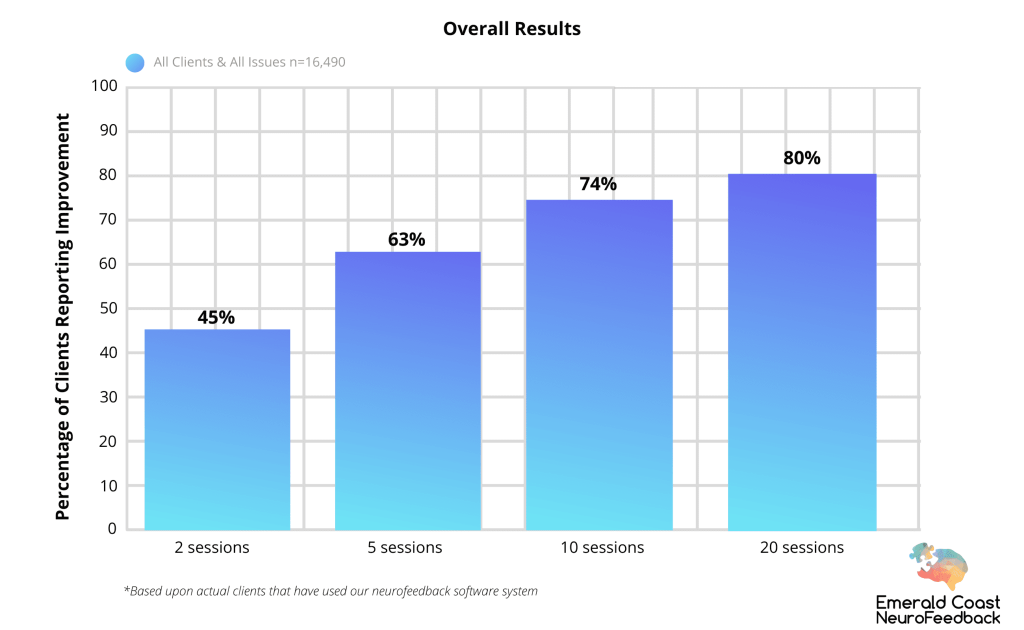
Long-Term Benefits of NeuroFeedback: What To Expect
Changing the way your brain functions seems like a daunting task, but it could be critical in helping you navigate various types of mental health disorders. Neurofeedback is one way to do this. It’s a non-invasive method for adjusting imbalances within the brain’s activity, allowing you to overcome many daily challenges. It can improve both function and the way you feel.
What Is Neurofeedback?
Neurofeedback, sometimes referred to as EEG biofeedback, is a medication-free, noninvasive method of treating anxiety disorders, ADHD, depression, sleep issues and other brain-focused conditions. While it has emerged as a cutting-edge wellness-focused approach to improving many mental health conditions, it can also be a game changer in stroke recovery and even enhance performance in academics, work or sports. With such a wide reach, Neurofeedback can profoundly enhance our quality of life by improving how the brain works at any age.
How Does Neurofeedback Work?
The brain is known as a complex adaptive system. This means that it is made up of billions of interconnected networks of neurons designed to adapt, learn and improve from feedback. This kind of learning, called latent learning, means it does not take conscious effort but happens in a similar way to learning to ride a bike. Sure, you still have to get on the bike and practice at first, but you don’t have to tell your feet how fast to turn the pedals continuously. Your body is getting feedback from gravity to learn to balance and propel forward at the same time.
The type of EEG-biofeedback provided at ECNF utilizes specialized software that allows the brain a window into its own functioning. This starts with a comprehensive evaluation process by a licensed therapist. This evaluation will allow you and the therapist to select the protocol most appropriate for your goals and customize it for your brain using an EEG.
From here, you will begin your feedback sessions twice a week, during which you will be provided audiovisual feedback (sounds and shapes on a computer screen). This feedback will help the brain optimize and self-correct patterns that have led to current symptoms and help you achieve your goals. It is a very easy and passive process.
The brain has an amazing capacity to change, but sometimes it needs some help to see how. For example, a mirror is helpful to show that you have some spinach in your teeth. In a similar way, EEG-Biofeedback provides your brain with a mirror of itself and allows it to self-correct in ways that would be difficult without such a tool. The EEG is a reflection of the patterns in your brain. The protocol delivered by sounds and pictures provides your brain with information on what to do to get out of this state that is causing your symptoms or inhibiting your goals.
How Long Does It Take to Get Results from Neurofeedback?
To get this kind of result, one might expect you have to keep working at it vigilantly and indefinitely, just as you would with fitness goals and athletics. But with Neurofeedback, that’s not the case.
At ECNF, we have found that most of the time, what the brain really needs from this process is a course correction. The EEG is a tool that shows the brain what it is doing, in real time, and then shows it what it should be doing instead (via the audio and visual feedback from your protocol).

Most people begin to see meaningful improvements in their areas of focus within 5–8 sessions (for those who are really tuned in and are good reporters of what’s going on for them or their child, mild to moderate improvements may be seen even after 1 or 2 sessions). However, this new learning is not yet solid enough to be lasting.
How Many Sessions Will I Need to Make Sure My Results From Neurofeedback are Lasting?
While every client is different, most people can expect to make lifelong improvements after just 20-30 sessions.
“The most evidence-based method for determining lasting results is to look for a plateau in progress over the previous 5-8 sessions at an average growth rate of 10% or less. This essentially acts as a ‘book end’ to solidify that learning. We have graphs that show us this measure for each area of focus, and we talk with clients about their specific goals and tailor the plan based on those goals so they know exactly where they stand throughout the process.”
How Long Will it Take Me to Get the Number of Sessions That I Need?
For this process to work efficiently, you will need to come in twice a week for an average of 10–15 weeks (approximately 3 months). The important thing to remember is that this kind of brain learning is synergistic. This means that consistency is key to gaining the needed momentum initially. If you want faster results and are willing to come in more often, this can potentially be shortened significantly.
Can I Get Faster Results if I Come in More Than Twice a Week?
Yes!
“At ECNF, we love intensives. It can be really exciting to see the kinds of changes that can happen so rapidly when people do have the ability to come for more sessions over a shorter period. We can sometimes see people for 2-3 sessions on the same day if we plan for this! So while 2 times a week is absolutely sufficient when that is what someone’s schedule allows, it is good to remember that Neurofeedback is a temporary commitment for a life-long result. We work with all of our clients to design the best plan and schedule to fit their needs, goals and lifestyle.”
In most cases, more frequent sessions are only going to increase that synergistic effect of brain learning. The more frequently you come, not only do you get to that 20-30 session average sooner, but those 20-30 sessions are, in effect, more like 30 to 40 because of the synergy. It’s a better value.
What if I Have a Planned Vacation or Can’t Come in One Week?
The standard benchmark for ensuring you have made some initial traction before taking a break is 8 sessions. Ideally, more, but eight is sufficient for short-term breaks like vacations or weeks when someone is unable to make it in.
Talk with the staff at ECNF to help you plan ahead and design the right program for your needs.
Why Choose Emerald Coast NeuroFeedback for Long-Term Wellness?
Unlike many other treatments and wellness practices, Neurofeedback is a relatively short-term commitment for long-term benefits.
While it is important that you communicate and plan ahead for your schedule with Neurofeedback, the ECNF staff is experienced in providing flexible options within that window of effectiveness and will work with you to find a way to make the process both effective and lasting.
Contact Emerald Coast NeuroFeedback to Explore a Change in Your Future
If you’re interested in long-term mental well-being, contact Emerald Coast NeuroFeedback. Schedule a consultation at either of our two locations to start exploring options.
